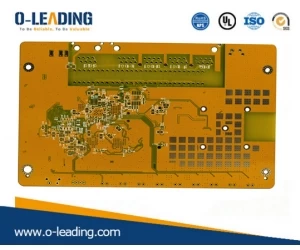How to deal with high speed PCB signal flow in circuit design
o-leading
o-leading.com
2018-08-21 16:48:12

1. The delay
Delay refers to the signal is transmitted at a limited speed on the transmission line of the PCB board, and the signal is sent from the sending end to the receiving end, during which there is a transmission delay. Signal delay will affect the timing of the system. The transmission delay mainly depends on the length of the wire and the dielectric constant of the medium around the wire. In the high-speed digital system, the signal transmission line length is the most direct factor that affects the phase difference of clock pulse. The clock pulse phase difference reduces the predictability of the signal along arrival. If the clock pulse phase difference is too large, the wrong signal will be generated at the receiving end.
Delay refers to the signal is transmitted at a limited speed on the transmission line of the PCB board, and the signal is sent from the sending end to the receiving end, during which there is a transmission delay. Signal delay will affect the timing of the system. The transmission delay mainly depends on the length of the wire and the dielectric constant of the medium around the wire. In the high-speed digital system, the signal transmission line length is the most direct factor that affects the phase difference of clock pulse. The clock pulse phase difference reduces the predictability of the signal along arrival. If the clock pulse phase difference is too large, the wrong signal will be generated at the receiving end.
2. The reflection
Reflection is the echo of a signal on a signal line. When the signal delay time is much longer than the signal hopping time, the signal line must be used as the transmission line. When the characteristic impedance of the transmission line does not match the load impedance, part of the signal power (voltage or current) is transmitted to the line and arrives at the load, but part is reflected. If the load impedance is less than the original impedance, the reflection is negative. Instead, the reflection is positive. Such reflections are caused by variations in the geometry of the wiring, incorrect wire ends, transmission through the connector and discontinuity of the power supply plane.

Reflection is the echo of a signal on a signal line. When the signal delay time is much longer than the signal hopping time, the signal line must be used as the transmission line. When the characteristic impedance of the transmission line does not match the load impedance, part of the signal power (voltage or current) is transmitted to the line and arrives at the load, but part is reflected. If the load impedance is less than the original impedance, the reflection is negative. Instead, the reflection is positive. Such reflections are caused by variations in the geometry of the wiring, incorrect wire ends, transmission through the connector and discontinuity of the power supply plane.

3. The crosstalk
Crosstalk is the coupling between two signal lines, mutual inductance and mutual capacitance between signal lines cause noise on signal lines. Capacitive coupling induces a coupled current, while perceptual coupling induces a coupled voltage. Crosstalk noise is caused by electromagnetic coupling between the signal line network, the signal system and the power distribution system, and the through-hole. It may cause false clock, intermittent data error and so on. In reality, crosstalk cannot be completely eliminated, but it can be controlled within the system's tolerance. The parameters of PCB plate layer, signal line spacing, electrical characteristics of driver and receiver, and baseline connection mode all have certain effects on crosstalk.
Crosstalk is the coupling between two signal lines, mutual inductance and mutual capacitance between signal lines cause noise on signal lines. Capacitive coupling induces a coupled current, while perceptual coupling induces a coupled voltage. Crosstalk noise is caused by electromagnetic coupling between the signal line network, the signal system and the power distribution system, and the through-hole. It may cause false clock, intermittent data error and so on. In reality, crosstalk cannot be completely eliminated, but it can be controlled within the system's tolerance. The parameters of PCB plate layer, signal line spacing, electrical characteristics of driver and receiver, and baseline connection mode all have certain effects on crosstalk.
4.Overshoot and undershoot
Overshoot is the first peak or valley value above the set voltage, for rising edge, is the highest voltage; For falling edge, the lowest voltage. Downstroking is when the next valley value or peak value exceeds the set voltage. Excessive overshooting can cause protective diodes to work, leading to premature failure. Overshooting can cause false clock or data errors.(High quality pcb manufacturer)
Overshoot is the first peak or valley value above the set voltage, for rising edge, is the highest voltage; For falling edge, the lowest voltage. Downstroking is when the next valley value or peak value exceeds the set voltage. Excessive overshooting can cause protective diodes to work, leading to premature failure. Overshooting can cause false clock or data errors.(High quality pcb manufacturer)
5. Oscillations and surround oscillations
Oscillations are repeated overruns and underruns. The oscillation of the signal, which is caused by the inductance and capacitance transiting the line, belongs to the underdamped state, while the circumferential oscillation belongs to the overdamped state. Oscillations and circular oscillations, like reflections, are caused by a variety of factors, and can be reduced by appropriate terminations, but cannot be completely eliminated.
Oscillations are repeated overruns and underruns. The oscillation of the signal, which is caused by the inductance and capacitance transiting the line, belongs to the underdamped state, while the circumferential oscillation belongs to the overdamped state. Oscillations and circular oscillations, like reflections, are caused by a variety of factors, and can be reduced by appropriate terminations, but cannot be completely eliminated.
































